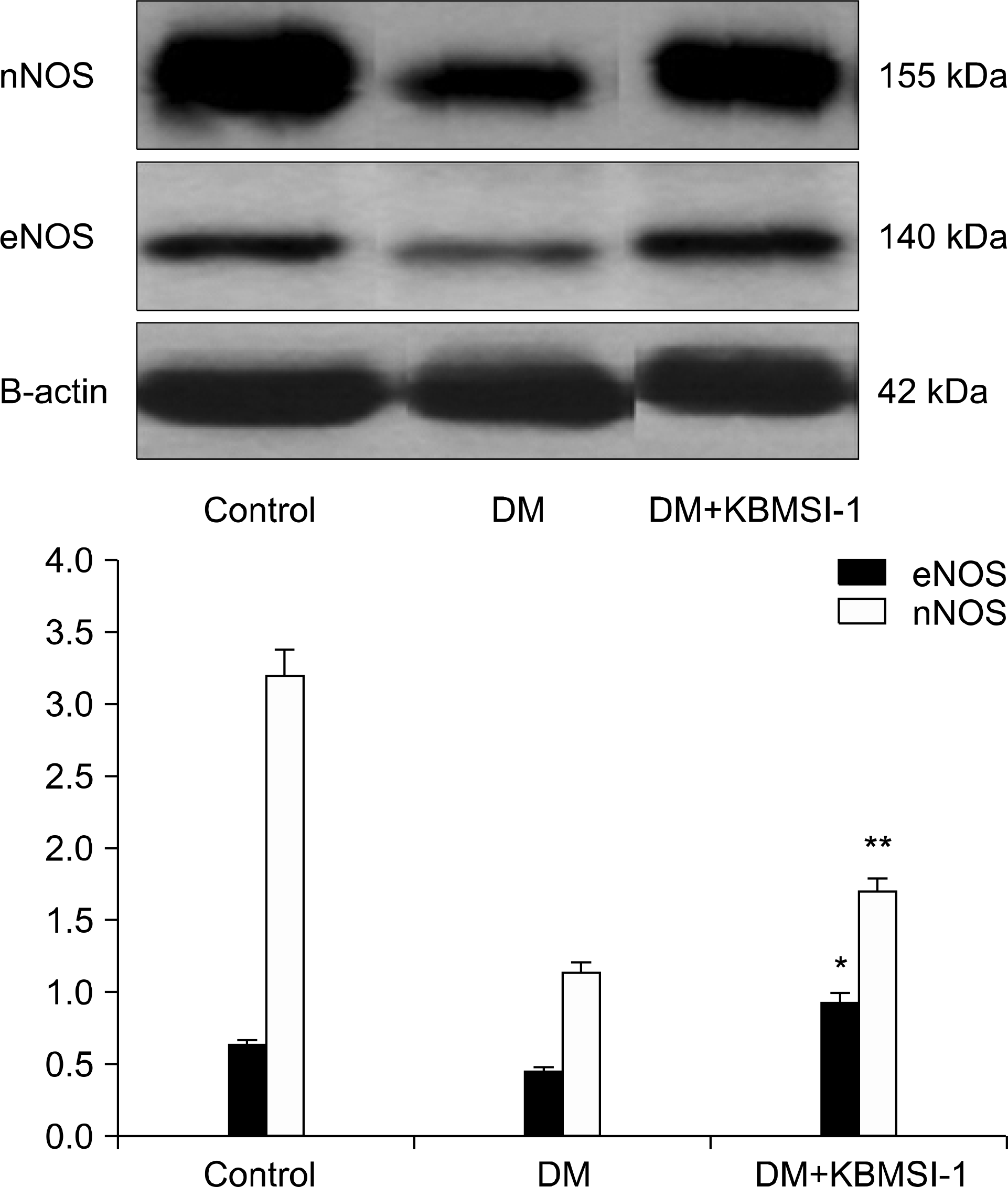Abstract
Purpose
The aim of this study was to investigate the effects of new herbal formula (KBMSI-1) on erectile dysfunction in streptozotocin-induced diabetic rat model.
Materials and Methods
We used male Sprague-Dawley rats aged 12 weeks and divided into three groups; control (n=8), diabetes (DM) (n=8), DM+KBMSI-1 200 mg/kg treatment (n=8) groups. The DM groups received a single intraperitoneal injection of streptozotocin (STZ). Distilled water was administered in the control and DM group. To investigate the penile erection, intracavernosal pressure (ICP) and intracavernosal pressure/mean arterial pressure (ICP/MAP) were recorded in all groups. Serial sections of the penis were used to perform Masson's trichrome stain. We analyzed the expression of nNOS and eNOS concentration in the isolated corpus cavernosum by western blotting.
Results
Peak ICP/MAP ratio was markedly increased in the treatment group with KBMSI-1 compared with DM group (p<0.05). Masson's trichrome staining of corpus cavernosum showed increase in smooth muscle volume and the regular arrangement of collagen fibers in KBMSI-1 treatment group compared with DM group. Western blot analysis revealed that the penile expressions of nNOS and eNOS protein were significantly higher in KBMSI-1-treated group than in DM group.
Go to : 
REFERENCES
1). Feldman HA, Goldstein I, Hatzichristou DG, Krane RJ, McKinlay JB. Impotence and its medical and psychosocial correlates: results of the Massachusetts Male Aging Study. J Urol. 1994; 151:54–61.

2). Vinik A, Richardson D. Erectile dysfunction in diabetes. Diabetes Reviews. 1998; 6:16–33.
4). Fink HA, Mac Donald R, Rutks IR, Nelson DB, Wilt TJ. Sildenafil for male erectile dysfunction: a systematic review and meta-analysis. Arch Intern Med. 2002; 162:1349–60.
5). Park CS, Ryu SD, Hwang SY. Elevation of intra-cavernous pressure and NO-cGMP activity by a new herbal formula in penile tissues of aged and diabetic rats. J Ethnopharmacol. 2004; 94:85–92.

6). Ahn TY, Kim KS, Kim CS, Park TH, Park HS. Effect of ginseng on the relaxation of the penile corpus cavernosal smooth muscle in rabbits. Korean J Ginseng Sci. 1996; 20:339–43.
7). Minhas S, Eardley I. Diabetic impotence. Carson C, Kirby R, Goldstein I, editors. Textbook of erectile dysfunction. 1st ed.Oxford: Isis Medical Media Publishers;1999. p. 541–50.
8). Karacan I. Diagnosis of erectile impotence in diabetes mellitus. An objective and specific method. Ann Intern Med. 1980; 92:334–7.
9). Fani K, Lundin AP, Beyer MM, Jimenez FA, Friedman EA. Pathology of the penis in longterm diabetic rats. Diabetologia. 1983; 25:424–8.

10). Rajfer J, Aronson WJ, Bush PA, Dorey FJ, Ignarro LJ. Nitric oxide as a mediator of relaxation of the corpus cavernosum in response to nonadrenergic, noncholinergic neurotransmission. N Engl J Med. 1992; 326:90–4.

11). Saenz de Tejada I, Goldstein I, Azadzoi K, Krane RJ, Cohen RA. Impaired neurogenic and endothelium-mediated relaxation of penile smooth muscle from diabetic men with impotence. N Engl J Med. 1989; 320:1025–30.

12). Podlasek CA, Zelner DJ, Bervig TR, Gonzalez CM, McKenna KE, McVary KT. Characterization and localization of nitric oxide synthase isoforms in the BB/WOR diabetic rat. J Urol. 2001; 166:746–55.

13). Cellek S, Rodrigo J, Lobos E, Fernández P, Serrano J, Moncada S. Selective nitrergic neurodegeneration in diabetes mellitus - a nitric oxide-dependent phenomenon. Br J Pharmacol. 1999; 128:1804–12.
14). Lee HA, Sim HS, Choi KJ, Lee HB. Hypoglycemic action of red ginseng components (II). Investigation of the effect of fat soluble fraction from red ginseng on enzymes related to glucose metabolism in cultured rat hapatocytes. Korean J Ginseng Sci. 1998; 22:51–9.
15). Chi YD, Mah SY, Xin ZC, Choi HK. Effect of Korean red ginseng on rabbit and rat corpus cavernosal smooth muscle. Korean J Ginseng Sci. 1997; 21:98–103.
Go to : 
 | Fig. 1.Masson's trichrome staining of corpus cavernosum in control group (A), diabetes group (B), KBMSI-1 treatment group (C). In the diabetes group, corpus cavernosum showed reduction of smooth muscles and irregular, distorted arrangement of collagen fibers. In the KBMSI-1 treatment group, corpus cavernosum showed increases volume of smooth muscles and the regular arrangement of collagen fibers (×100, ×400). |
 | Fig. 2.Muscle distribution (muscle/collagen ratio) of penile corpus cavernosal smooth muscle. DM: diabetes group, DM+ KBMSI-1: diabetes group treated with KBMSI-1. ∗Significantly different (p<0.05) from DM group. |
 | Fig. 3.Western blot analysis showing the protein expression of eNOS and nNOS. eNOS: endothelial NO synthase, nNOS: neuronal NO synthase. ∗,∗∗Significant different (p<0.05) from DM group. |
Table 1.
Composition of herb formula (KBMSI-1) ingredients
Table 2.
Changes of body weight and fasting serum glucose level in the experimental groups
Table 3.
Intracavernosal pressure in the response to electrical stimulation of cavernous nerve in rats of each group
| Control | DM | DM+KBMSI-1 | p-value | |
|---|---|---|---|---|
| Peak ICP (mmHg) | 43.4±3.07 | 10.3±1.27 | 20.70±1.10 | <0.05∗ |
| MAP (mmHg) | 123.5±9.89 | 63.5±4.15 | 94.46±6.09 | <0.05∗ |
| ICP/MAP (ratio) | 0.35±0.03 | 0.16±0.02 | 0.22±0.02 | <0.05∗ |




 PDF
PDF ePub
ePub Citation
Citation Print
Print


 XML Download
XML Download